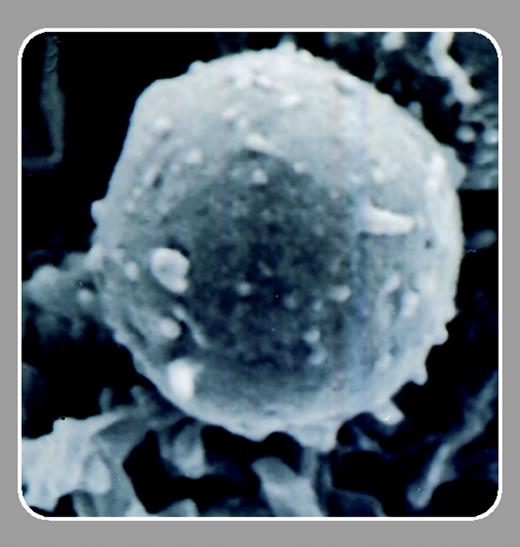Circulating lymphocytes exhibit an intriguing segregation of adhesion proteins with respect to microvillar membrane domains. Proteins such as L-selectin that mediate initial tethering to endothelial cells are enriched at the tips of microvilli, a distribution that has been shown to enhance the frequency at which rolling is initiated.1 In contrast, integrins such as leukocyte function-associated antigen 1 (LFA-1) that are involved in strong adhesion are distributed randomly or are enriched on the lymphocyte cell body. Endothelium-displayed chemokines trigger a rapid up-regulation of integrin avidity through a process involving release of integrins from the cortical actin cytoskeleton.2 This leads to the arrest of the lymphocyte on the endothelium and, ultimately, to transmigration across the endothelium. Scanning electron microscopy studies have shown that initial contact between the lymphocyte and the endothelium is made by contacts with the tips of microvilli, whereas strong adhesion is associated with both a loss of microvilli and the formation of contacts with irregular surface folds on the lymphocyte cell body. It has been proposed that the relative paucity of LFA-1 in the microvillar tips functions to diminish nonspecific adhesion to blood vessels and that chemokine-induced loss of microvilli is important for the formation of strong adhesive contacts.1
In this issue, Brown and colleagues (page 3890) address the mechanisms regulating microvillar remodeling in chemokine-stimulated T cells. This study draws from lessons learned in cell biology, where members of the ezrin/radixin/moesin (ERM) family are known to link cell surface and cytosolic proteins to the actin cytoskeleton and to recruit these proteins into microvilli.3 Brown and coworkers show that in human peripheral blood T cells, the loss of microvilli upon chemokine stimulation is accompanied by dephosphorylation of moesin and ezrin at a specific C-terminal threonine known to control ERM linker activity by regulating an intramolecular autoinhibitory interaction. ERM dephosphorylation is accompanied by loss of these proteins from the cytoskeletal fraction, in keeping with the idea that dephosphorylation inhibits linker activity. As expected for chemokine-induced signaling, ERM dephosphorylation is very rapid and sensitive to G-protein inhibitors. Further substantiation of the role of ERM proteins in organizing T-cell microvilli comes from experiments showing that expression of a dominant-negative ERM mutant leads to complete loss of microvilli whereas expression of a constitutively active form of moesin leads to increased microvillar structures.
This work convincingly demonstrates that ERM proteins are key regulatory players in chemokine-induced microvillar remodeling and leads to interesting ideas about how the cytoskeleton controls adhesion and extravasation. However, additional work will be needed before this process is fully understood. Brown and coworkers show that ERM dephosphorylation is inhibited by treatment with calyculin A and basal phosphorylation is decreased by treatment with staurosporine and that these drugs lead to changes in microvillar structure. However, the relevant kinases and phosphatases are yet to be identified. A second outstanding issue arises from the finding that the constitutively active moesin mutant delays but cannot prevent dissolution of microvilli in response to chemokine treatment. This finding indicates that phospho-ERM proteins are not sufficient to maintain microvilli, implicating other microvillar constituents in this process.


This feature is available to Subscribers Only
Sign In or Create an Account Close Modal